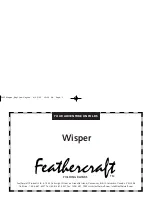
1-4
Boating Safety
• Ensure that the load of persons, ballast, and equipment is within the limits stated on
the USCG Maximum Capacities Plate and is properly distributed based on
instructions in this manual.
• Check that all safety equipment and life jackets, personal flotation devices (PFDs),
and throwable cushions are in good condition and suitable for your boat and
passenger load.
• Inform all passengers where safety equipment is located and how to use it.
• Have at least one other passenger who is capable of operating the boat safely in case
of an emergency.
Gasoline vapors can explode. Before starting engine operate
blower for 4 minutes and check engine compartment bilge for
gasoline vapors.
-
It is very important to open the engine cover and check the engine compartment
and bilge for liquid gasoline and gasoline vapors prior to each use of your boat
and after refueling. Failure to do so may result in fire or explosion as well as
serious injury or death to you and/or others.
-
If you see liquid gasoline in the engine compartments/bilge or smell gasoline
vapors, DO NOT attempt to start the engine. Liquid gasoline in the bilge is an
extreme fire and explosion hazard which may cause injury or death. Find and fix
the source of the leakage, remove the liquid gasoline from the bilge. Then
ventilate the engine compartment/bilge and run the blower to remove all gasoline
vapors before starting the engine.
-
If gasoline vapors persist after running the blower, DO NOT attempt to start the
engine. Likely, there is a gasoline leak that is creating the excessive vapor.
-
Always operate blower below cruising speed and after stopping the boat.
Precautions While Underway
Failure to follow these precautions will result in serious injury
or death.
The operator shall:
• Check that the area behind the boat is all clear before starting the engine to AVOID
PROPELLER INJURY to persons in the water behind the boat or on the swim
platform.
• Turn off the engine prior to anyone occupying the swim platform or being in the
water behind the boat to AVOID PROPELLER INJURY. Being in neutral gear is
insufficient; the propeller may still be turning, or engine may be inadvertently shifted
into gear.
• Not back the boat toward persons in the water behind the boat to AVOID
PROPELLER INJURY.
• Not allow people to be on or near the swim platform or in the water near the swim
platform while the engine is running because CARBON MONOXIDE will exist
around the back of the boat when the engine is running. Engine exhaust contains
carbon monoxide, which is a deadly, odorless, colorless gas.
!
WARNING
!
Chapter 1_15_Axis.qxp_ Chapter 1 doc.qxd 6/27/14 12:09 PM Page 4
Summary of Contents for Wake Research
Page 1: ......
Page 3: ...ii Notes...
Page 5: ...iv Notes...
Page 39: ...1 30 Boating Safety Refer to the diagram below for the location of each label...
Page 67: ...1 58 Boating Safety Notes...
Page 69: ...Gauges Controls 2 2 Tachometer...
Page 70: ...2 3 Gauges Controls...
Page 71: ...Gauges Controls 2 4...
Page 72: ...2 5 Gauges Controls...
Page 73: ...2 6 Gauges Controls...
Page 74: ...Gauges Controls 2 7 Speedometer...
Page 75: ...Gauges Controls 2 8...
Page 135: ...W 10 Warranty Notes...
Page 136: ......














































